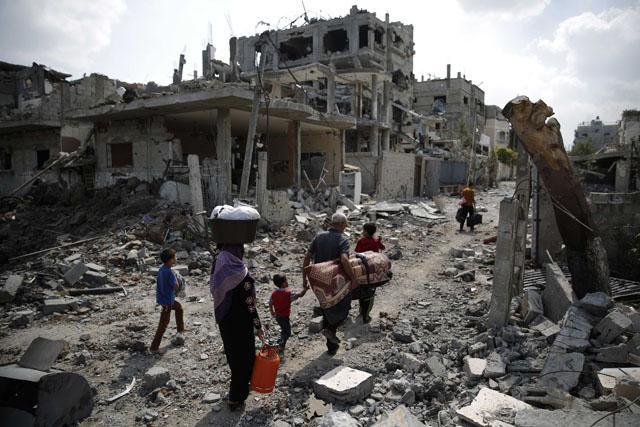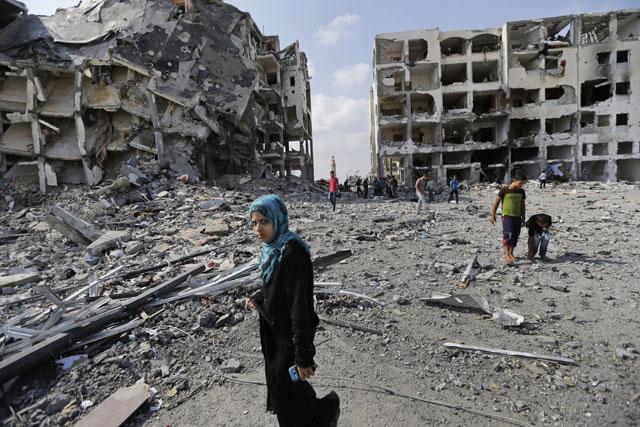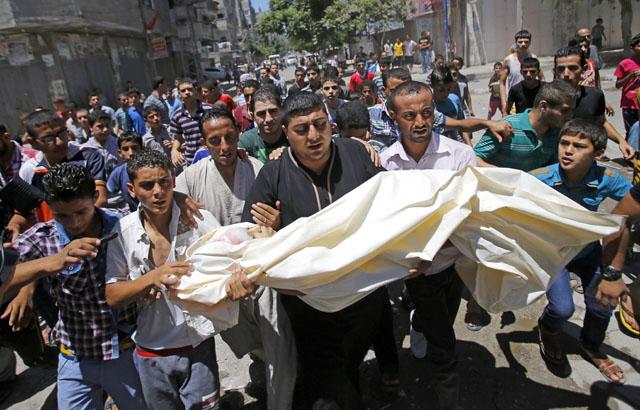You are here
Gazans return to homes, shocked by devastation
By AFP - Aug 05,2014 - Last updated at Aug 05,2014

BEIT HANOUN, Palestinian Territories — Khayri Hasan Al Masri fled his home in Beit Hanoun with his wife and three children nearly three weeks ago when Israel announced the launch of its July 17 ground offensive.
They left a tidy white house, with its grassy courtyard, a palm tree and a lemon tree.
But when he returned on Tuesday to this small town in northern Gaza as a 72-hour ceasefire took hold, he was confronted by scenes of utter destruction.
“Is this is really my town?” he asks, dumbfounded, gawping at the gutted, collapsed homes.
At the edge of the sandy streets, Israeli tank tracks left their imprint and donkeys lay dead.
The structure of his home is still intact but there are gaping holes in the walls. The bedroom of his 11-year-old son Hasan is covered in cartridges. A mortar lies in the living room, a bazooka upstairs.
A map of the local area has been scrawled on one wall in Hebrew suggesting Israeli soldiers used his home as some kind of base after the family fled.
Khayri returned alone, sparing his immediate family the ordeal of seeing the devastation.
“What am I going to tell my wife and children? I don’t want them to see this! They will go crazy. How can I explain all this?” he sighed, crunching over debris under foot.
“What did we do to him, [Benjamin] Netanyahu?” he asks of Israel’s prime minister.
Khayri is one of thousands of Gazans who used the 72-hour Egyptian-brokered truce, to venture out to see if their homes were still standing.
UN agency OCHA says 267,970 Palestinians have been sheltering in 90 UN-run schools, with thousands more housed in government schools and another 200,000 are believed to be staying with host families.
Widow Zakia Shaban Bakr Masri, 74, her face framed by a headscarf the same green as the lemons hanging in Khayri’s garden, walks with a heavy heart over what remains of her family home.
“As soon as I returned, I cried,” she whispers in a shrill tone.
“All my life savings were here, in my room. I have nothing left.”
Destroy to rebuild
Mohammed, 22, found similar devastation.
His family’s apartment stands gutted, gaping holes puncturing the walls, the masonry burnt by the fighting. Cockerels wander through the street. A drone sweeps the sky.
“Everything is destroyed. Buildings are no longer habitable. Everything will have to be knocked down to be rebuilt. Until then, we have nowhere to live,” he says.
The Palestinian government is just only starting to count the cost.
“Thousands of homes have been completely destroyed, plus there are all those that were partially damaged,” said Mufid Hasayneh, minister of public works. He wants a conclusive end to the fighting so that painful reconstruction can begin with help from foreign donors.
Palestinian Deputy Economy Minister Taysir Amro told AFP he estimated war damage at $4 to $6 billion, warning the figure could rise as more indirect losses are calculated.
For now, Gazans have a wait-and-see-attitude when it comes to planning reconstruction. They say they will assess the situation, hoping for an end to the nightmare of fighting between Israel and Hamas.
Only a handful of the most brave will spend the night camped out among the debris.
Khadar Al Masri has moved a mattress under a concrete slab that threatens to give way at any moment. “It’s dangerous,” he acknowledged.
“I’ll stay here during the truce. If the war resumes, I’ll go back” to a shelter.
“All this is a test from God, but don’t misunderstand: we will pick ourselves up again.”
Related Articles
A 72-hour truce took hold in Gaza on Tuesday as Israel withdrew troops following four weeks of bitter fighting and Palestinians ventured out to find scenes of destruction.
Cradling his baby daughter, Saeed Masri took flight Friday from renewed Israeli bombardment of Gaza with little faith that even a UN facility can protect his family.
Doctors and aid agencies are trying to capitalise on a truce in Gaza to evacuate more wounded Palestinians for life-saving medical treatment in East Jerusalem, Israel and Jordan.

Opinion
Apr 09, 2025
Apr 08, 2025
- Popular
- Rated
- Commented
Apr 08, 2025
Apr 09, 2025
Newsletter
Get top stories and blog posts emailed to you each day.
















